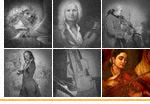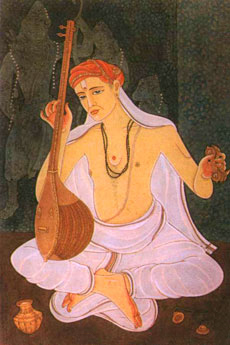INDIAN CARNATIC MUSIC: SARA SARA
SECTION 6.7
| Sara Sara - Indian Carnatic Music |
Sara Sara, a Carnatic instrumental piece, was composed by Tyāgarāja (1767-1847), a South Indian composer. Indian music is a highly developed art form, and although performing traditions have been transmitted orally, the theoretical basis for Indian music has been described in manuscripts for centuries. Two of the earliest manuscripts to describe significant aspects of Indian classical music theory are the Nātyaśāstra (musical portions in this manuscript are estimated to have been written in the 4th-5th centuries), and the Sangīta-ratnākara (written between 1210 and 1247).
There are two major musical systems in India: Carnatic (Karnatik), the music of southern India, and Hindustani, the music of northern India. Although the music of northern and southern India share many similarities, their music began to diverge from the thirteenth century on when northern India became subject to Islamic rule. Carnatic and Hindustani music are both based on two main elements: raga and tala. Raga is the basis for the melody, and is a specific set of notes in ascending and descending scales (melodic modes), and tala is the rhythmic pattern used in the music (metric cycles). In Carnatic music, ragas are classified into approximately 72 main scales or melakartas, and 35 principal rhythms or talas.
Carnatic music generally has three layers of musical activity:
- The melodic layer. This layer is comprised of a melodic soloist, and melodic accompanist. Although the voice is often used for the melody, other melodic instruments frequently used include the violin, vina (a large plucked lute), bansuri (a bamboo flute), nagasvaram (an oboe), and saxophone.
- A percussion layer. The most frequently used percussion instrument is a double-headed drum called the mridangam. Other percussion instruments include the tavil (a drum), a tambourine (kanjira), mouth harp (morsang) and a clay pot (the ghatam).
- The drone or sruti layer. The sruti layer is often played by a specialized instrument such as the tambura, a four-stringed plucked instrument with a buzzing timbre.[59] [60] [61]
Ornaments or gamaka are another significant element of Carnatic music. There are three broad classes of ornamentation (gamakas) in Carnatic music: slides (ascending and descending), deflections (often performed as a rolling or sliding oscillation or shake of the note), and fingered stresses (often performed as a mordent, turn or grace note). [62] [63]
Three sample ornaments are presented below using western musical notation. The ornament’s notation and ornament symbol are found in the first measure of each example, and the notation of what the ornament should sound like is found in the second measure of each example.

Ex. 1 Ascending Slide (etrajaru)
To play the ascending slide in Ex.1, use a sliding glissando or portamento sound as you let your finger slide from the F# up towards the note A.

Ex. 2 Deflection (kampita)
To play the deflection in Ex. 2, using the tip of your finger, start on the note and roll back then forward twice as if you were doing two vibrato shakes in a backwards motion.

Ex. 3 Fingered Stress (pratyahata)
To play the fingered stress in Ex. 3, let your finger rapidly strike the lower note in a fashion similar to playing a mordent.
Since the stringed instruments such as the violin, viola and cello are unfretted, they are ideally suited to play the ornaments commonly used in Carnatic music. Balaswami Dishitar (1786-1858), younger brother of the composer Muttusvāmi Dīkshitar, was one of the earliest Carnatic musicians to adapt the violin to South Indian music, and other early Carnatic violinists include Varahappa Iyer, Shri Vadivelu and Krishaswami Bhagavatar. Due to the influence of these musicians, the violin has become one of the most popular instruments used as a melodic accompaniment for Carnatic vocal music and as a solo instrument. [64] [65] Although there are some Carnatic musicians who play the viola or the cello, these instruments are not as commonly used as the violin to play Carnatic music.
Western notation and fixed pitches are not typically used in Carnatic music. As a simplified explanation, Carnatic music uses the relative pitch of seven svara, or Carnatic scale degrees: sa (tonic or first degree of the scale); ri (or re, the second degree of the scale); ga (third); ma (fourth); pa (fifth); da (sixth); ni (seventh). These syllables, sa-ri-ga-ma-pa-da-ni are roughly comparable to the following tonic solfa notation used in English speaking countries: do-re-mi-fa-sol-la-ti. Other contributing factors to the ways Carnatic scales are structured include microtones, melodic elements and particular ways to treat scale degrees, but these complex topics will not be discussed at the present time. Since fixed pitches are not generally used with Carnatic music, Carnatic stringed instruments are often tuned differently than western stringed instruments. One of the common Carnatic tunings for stringed instruments is: sa-pa-sa-pa. As an illustration of what this would sound like using western notation, if the vocalist or soloist decided the starting pitch of sa would be F (below middle C), Carnatic violin tuning for this piece would be:

Carnatic tuning Western tuning
TECHNIQUE TIPS: Sara Sara was composed by Tyāgarāja (1767-1847), a famous South Indian composer who played a key role in the development of South Indian classical art music. He was one of the Carnatic "trinity" of composers (the other two members of the Carnatic trinity were Muttusvāmi Dīkshitar and Śyāma Śāstri). Tyāgarāja was noted for his use of devotion and emotion in his music, and most of his music was in honor of the Hindu god Rama. He composed over 700 pieces, and used many different rāgas in his compositions (most of his pieces were a song form called kriti, comprised of three parts called pallavi, anupallavi and caranam). Tyāgarāja’s music is still regarded as a significant part of the repertoire of Carnatic music, and is frequently performed by Carnatic musicians today. The raga (melodic mode) of Sara Sara is called kuntalavarali and the tala (meter) is Adi (the Adi meter or tala is grouped in an eight beats per measure pattern in this arrangement). [66]
Carnatic violinists and violists use a different playing position than western string players. Violinists and violists experimenting with Carnatic styles of playing may want to try this. Sit cross-legged on the floor, and let your scroll bend down and rest on the ankle of your right foot, and let the bout of your viola or violin rest against your chest. Since your left hand won’t need to hold the neck of your instrument up, it will be much easier to freely move your left hand up and down the fingerboard as you finger notes and perform improvised ornamentation (gamaka). You may want to experiment with ornaments such as slides, deflections and fingered stresses as you play this piece. If you would like to listen to examples of Carnatic stringed instrumental music, there are numerous online video and audio clips of Carnatic string players on the Internet (mostly violinists and a few violists). Visit a few of these sites, see how the music is performed, and experiment with imitating the sounds you hear. If you like this style of music, you may want to consider taking lessons from a Carnatic string player. Even today, Carnatic performing traditions are primarily transmitted orally from teacher (guru) to student (disciple or shishya). [67]
© Copyright 2024 RK Deverich. All rights reserved.
*Although this online viola class is provided free of charge, all rights are reserved and this content is protected by international copyright law. It is illegal to copy, post or publish this content in any form, and displaying any of this material on other websites, blogs or feeds is prohibited. Permission is given for individual users to print pages from this website for their personal, non-commercial use.



